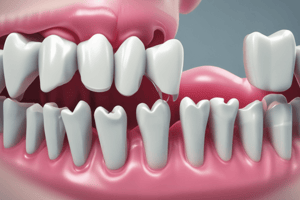Podcast
Questions and Answers
What is the consistency of the enamel matrix?
What is the consistency of the enamel matrix?
What happens to the ameloblasts after eruption?
What happens to the ameloblasts after eruption?
What is the characteristic of matured enamel in terms of radiopaquity?
What is the characteristic of matured enamel in terms of radiopaquity?
What is the name of the structure associated with the thickened cell membrane of the ameloblast?
What is the name of the structure associated with the thickened cell membrane of the ameloblast?
Signup and view all the answers
What is the fate of the ameloblasts after they become low cells?
What is the fate of the ameloblasts after they become low cells?
Signup and view all the answers
What is the characteristic of matured enamel in terms of birefringence?
What is the characteristic of matured enamel in terms of birefringence?
Signup and view all the answers
What is the process called when the distal ends of the Tomes process are filled with matrix material?
What is the process called when the distal ends of the Tomes process are filled with matrix material?
Signup and view all the answers
What is the hardest calcified tissue in the body?
What is the hardest calcified tissue in the body?
Signup and view all the answers
What is the name of the structure that persists as the neck of the tooth after eruption?
What is the name of the structure that persists as the neck of the tooth after eruption?
Signup and view all the answers
What is the process called when the ameloblasts secrete enamel matrix?
What is the process called when the ameloblasts secrete enamel matrix?
Signup and view all the answers
Study Notes
Enamel Formation and Development
- Ameloblasts play a role in the maturation of formed matrix and enamel formation is complete with a hypomineralized structure.
- Ameloblasts move from production to active transport of materials into the already partially mineralized enamel during mineralization.
- After apposition and maturation, ameloblasts become parts of the reduced enamel epithelium (REE).
Enamel Structures
- Enamel rods are the crystalline structural units of enamel.
- Enamel rods run in a perpendicular direction to the surface of dentin with a slight inclination toward the cusp tip.
- Near the cusp tip, the rods are more vertical, and at the cervical area, they are horizontal.
- Enamel rods bend right or left in rod groups, increasing masticatory strength.
Enamel Maturation and Apposition
- During apposition, ameloblasts produce and secrete enamel matrix proteins.
- After apposition, ameloblasts become involved in the maturation of the enamel matrix.
- The reduced enamel epithelium (REE) fuses with the oral mucosa, creating a canal for the enamel cusp tip to erupt through the oral cavity.
Enamel Microscopic Features
- Striae of Retzius are series of lines extending from the DEJ toward the tooth surface.
- Hunter-Schreger bands are an optical phenomenon produced by changes in direction between adjacent groups of enamel rods.
- Perikymata and imbrication lines are wavelike features found on the surface enamel of teeth, particularly on canines, maxillary central incisors, and first premolars.
Enamel Defects and Clinical Considerations
- Amelogenesis imperfecta is a defect resulting from faulty enamel formation.
- Febrile diseases, tetracycline, and fluoride can cause enamel defects.
- Attrition, abrasion, erosion, and enamel caries are clinical considerations for enamel.
- Deepened pit and groove patterns are seen on the lingual surface of anterior teeth and the occlusal surface of posterior teeth.
Age Changes
- Wear facets, discoloration, and reduced permeability are age-related changes in enamel.
Enamel Composition and Properties
- Enamel is a crystalline material, 96% inorganic, 1% organic, and 3% water.
- Enamel is avascular and can endure crushing pressure of 100,000 lbs/sq inch.
- The crystalline formation of mature enamel consists mainly of calcium hydroxyapatite, with small amounts of carbonates, magnesium, potassium, sodium, and fluoride.
Studying That Suits You
Use AI to generate personalized quizzes and flashcards to suit your learning preferences.
Description
This quiz covers the formation and development of enamel in teeth, including the role of ameloblasts and the structure of enamel rods.



